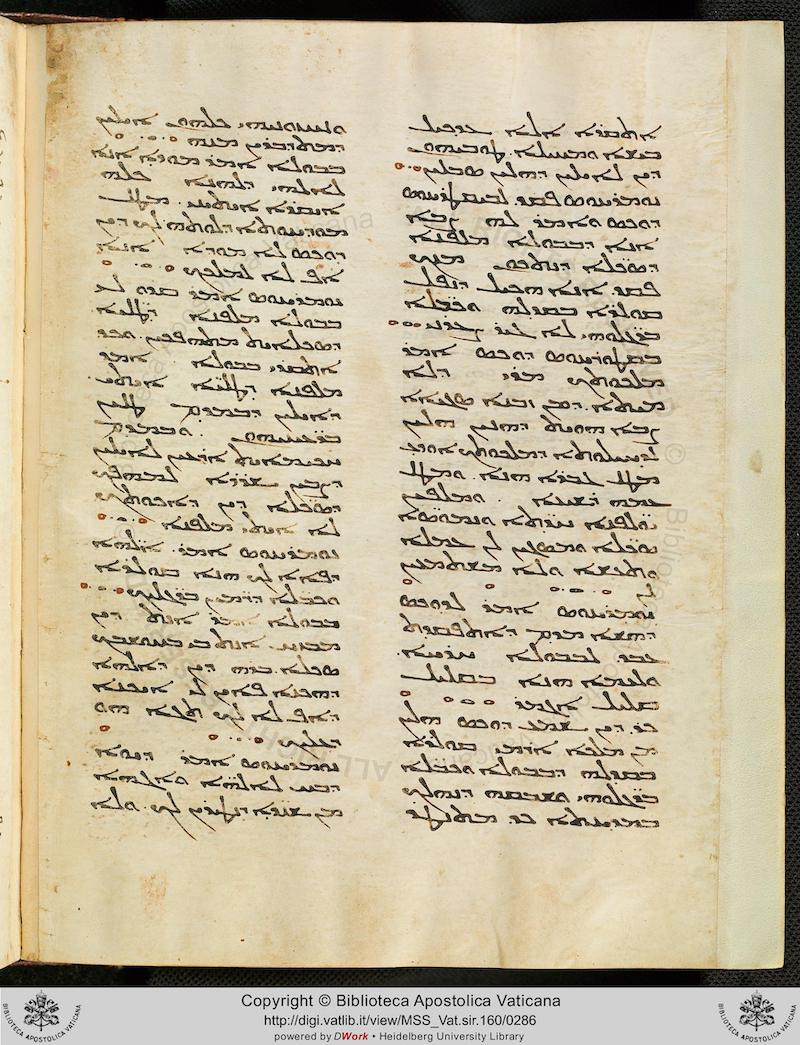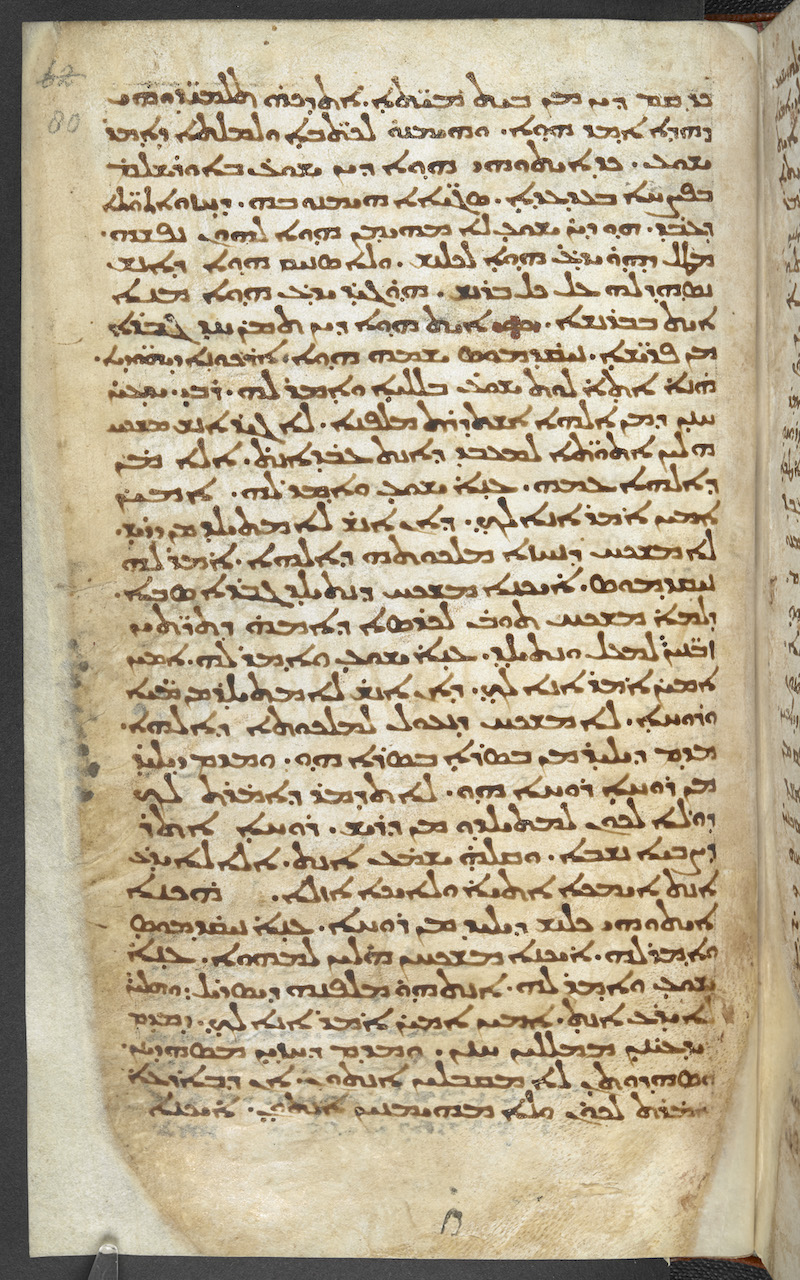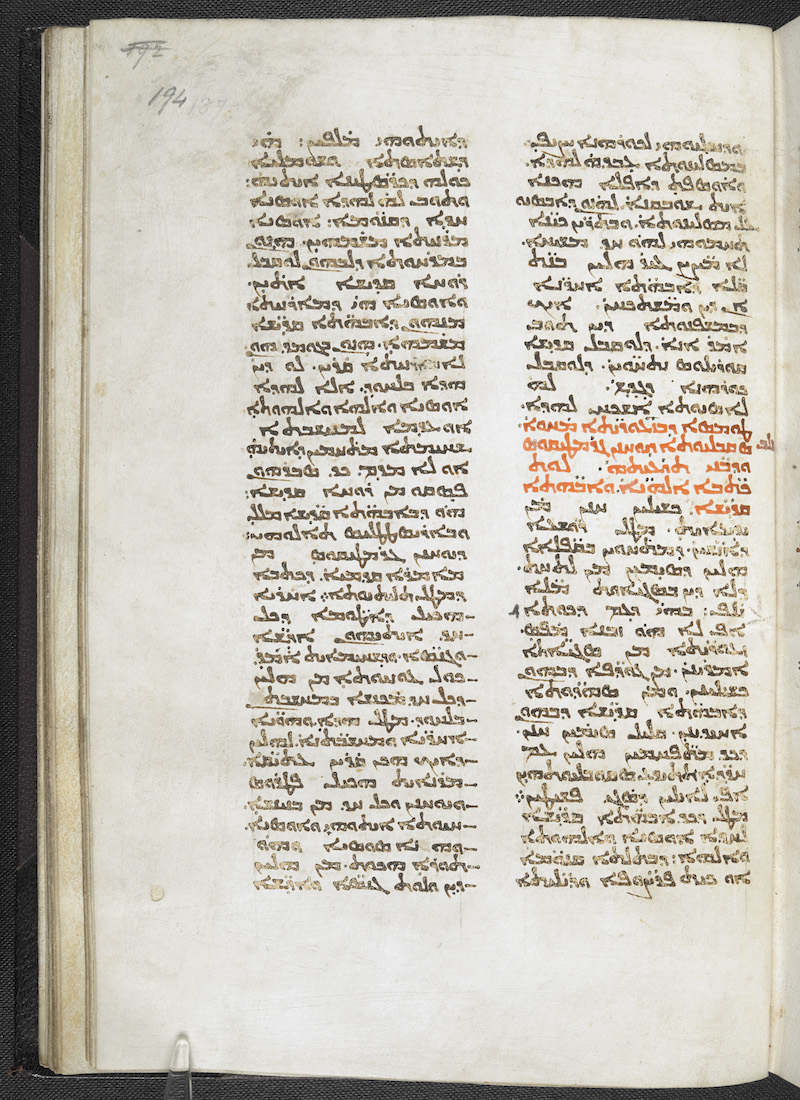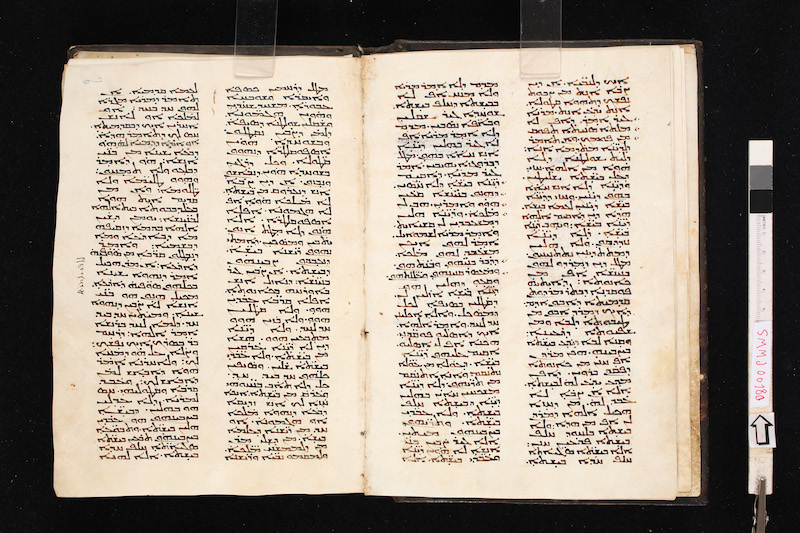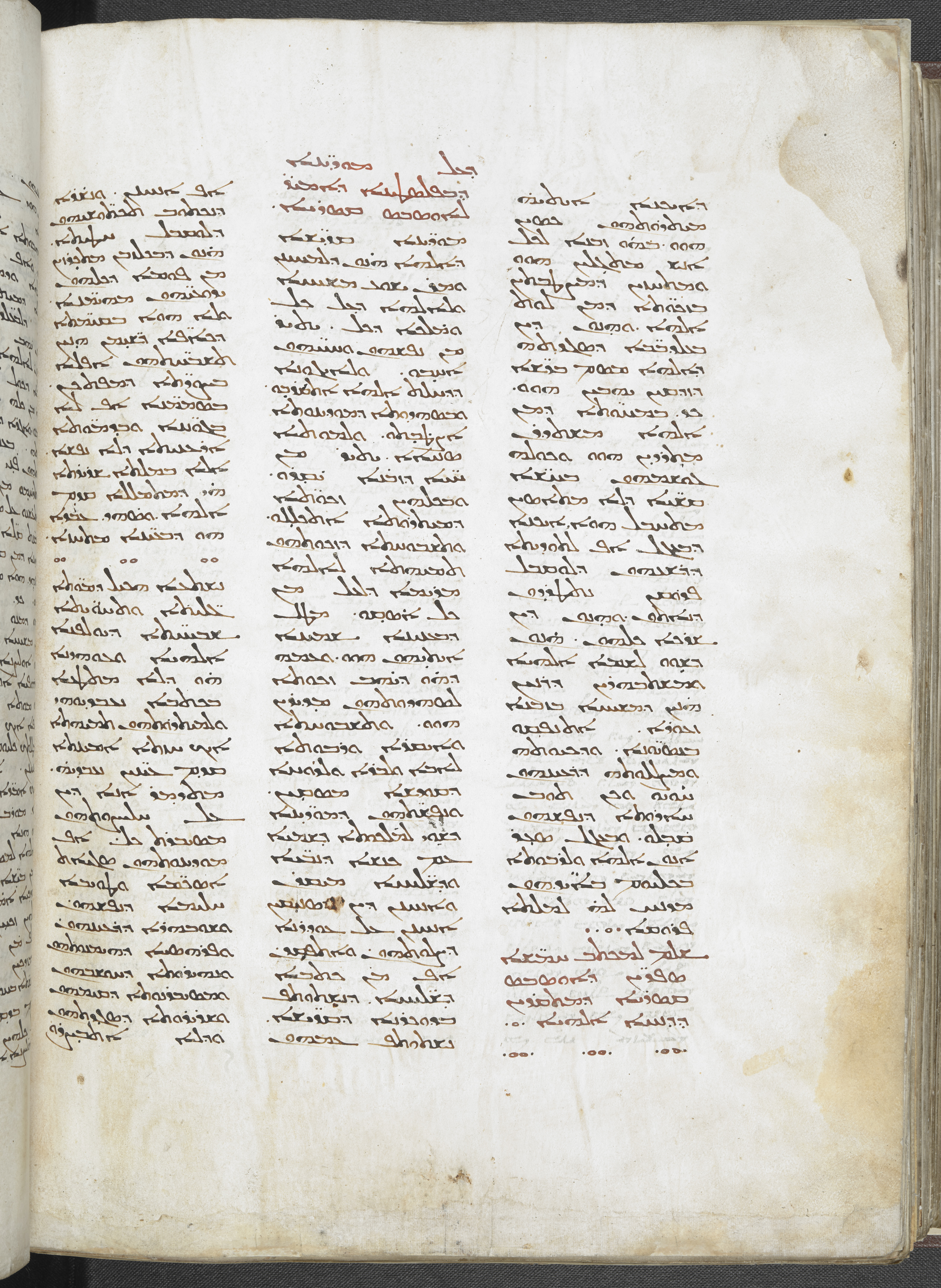
Estrangela, 8th century
-
Title
Clementine Recognitions; Titus of Bostra: Against the Manicheans; Eusebius: On the Theophany, On the Confessors of Palestine, Panegyric on the Martyrs; A martyrology -
Text
Eusebius, On the Theophany (conclusion) and On the Confessors of Palestine (beginning) -
Language(s)
Syriac -
Writing System
Syriac -
Script(s)
Estrangela -
Country
Great Britain -
City
London -
Repository
British Library -
Shelf Mark
Add. 12150, fol. 235v -
Century
8th century -
Year Range
723-723 -
Date Precise
November 723 CE -
Place Of Origin
Edessa -
Provenance
Fol. 254r, col. 3: colophon written in green, doxology in yellow, dated Tishrin II (= November), 723 in Edessa. Deir al-Suryan Fragment 27 belongs to the same manuscript; see Sebastian Brock and Lukas Van Rompay, Catalogue of the Syriac Manuscripts and Fragments in the Library of Deir al-Surian, Wadi al-Natrun (Egypt), Orientalia Lovaniensia Analecta, 227 (2014), p. 389-392. -
Bibliography
William Wright, Catalogue of Syriac Manuscripts in the British Museum acquired since the year 1838, vol. 2 (1871), pp. 631-633.
Samuel Lee, ed., Eusebius.... on the Theophania of Divine Manifestation of Our Lord and Savious Jesus Christ (1843).
William Cureton, ed., History of the Martyrs in Palestine (1861).
255 leaves, on parchment. 3 columns, 38-43 lines per column; support dimensions 37 x 28.25 cm
In 1398 AG “some careful student and admirer of antiquity” recorded in the margin of f. 239v information from a part of the manuscript no longer extant that the scribe’s name was Yaʿqob (b-iday (ʾ)nāš d-metqrē Yaʿqob). As Lee remarks in his edition (p. xii), it is telling that the author of this note already considered the book ancient (ktābā hānā ʿattiqā).
This page contains the end of Eusebius’ On the Theophany and the beginning of his work On the Confessors of Palestine.
Acknowledgements: Described by Adam McCollum
Transcription
col. a
01 ܕܐܝܟܢܐ ܐܝܬܝܗ̇
02 ܡܝܬܪܘܬܗܘܢ ܟܣܝܢ
03 ܗܘܘ· ܒ̇ܗܘ ܙܒܢܐ ܠܟܠ
04 ܐܢܫ ܡܬܓ̣ܠܝܢ ܗܘܘ
05 ܘܡܬܚܙܝܢ ܕܡܨܛܒܬܝܢ
06 ܒܙܟܘ̈ܬܐ ܕܡܢ ܠܘܬ
07 ܐܠܗܐ. ܘܗ̣ܢܘܢ ܕܝܢ
08 ܒܥܠܕܒ̈ܒܐ ܕܣܓܕܬܗ
09 ܕܐܠܗܐ ܡܣܡ ܒܪ̈ܫܐ
10 ܕܙܕܩܝܢ ܝܗܒܝܢ ܗܘܘ.
11 ܟܕ ܒܡܚ̈ܘܬܐ ܕܡܢ
12 ܐܠܗܐ ܡܫܬܕܪܢ
13 ܡܬܪܕܝܢ ܗܘܘ ܘܟܘܠܗ
14 ܓܘܫܡܗܘܢ ܒܚ̈ܫܐ
15 ܩܫ̈ܝܐ ܕܠܐ ܡܬܐܣܝܢ
16 ܡܬܚܒܠ ܗܘܐ. ܐܝܟܢܐ
17 ܕܒܥܓܠ ܐܦ ܠܬܘܕܝܬܐ
18 ܕܪܫܥܗܘܢ ܕܠܘܩܒܠ
19 ܦܪܘܩܢ ܢܬܛܪܕܝܢ
20 ܕܢܐܬܘܢ. ܘܗ̣ܢܘܢ ܕܝܢ
21 ܫܪܟܐ ܟܠܗܘܢ. ܗ̇ܢܘܢ
22 ܕܫ̣ܘܘ ܠܫܡܐ ܐܠܗܝܐ
23 ܘܡܫܬܒܗܪܝܢ ܕܪܢܝܢ
24 ܗ̇ܢܝܢ ܕܡܫܝܚܐ ܒܙܒܢܐ
25 ܙܥܘܪܐ. ܐܬܢܦܩ̣ܘ
26 ܒܢܣܝ̈ܘܢܐ. ܘܕܟܝܘܬܗ
27 ܘܡܨܠܠܘܬܗ ܕܪܥܝܢܗܘܢ
28 ܚ̇ܘܝܘ ܘܟܢ ܬܘܒ
29 ܚܐܪܘܬܐ ܕܢܦܫܗܘܢ
30 ܩ̇ܒ̣ܠܘ. ܘܒܥܓܠ ܣܥ̣ܪ
31 ܐܢܘܢ ܐܠܗܐ ܘܠܪܒܘܬܐ
32 ܒܟܠܝܘܡ ܒܐ̈ܝܕܗܘܢ
33 ܡܕܢܚ ܠܗ̇ ܠܡܠܬܐ
34 ܦܪܘܩܝܐ . . . .
35 ܫܠܡ ܠܡܟܬܒ ܚܡ̈ܫܐ
36 ܣܦܪ̈ܝܢ ܕܐܘܣܒܣ
37 ܩܣܪܝܐ ܕܡܬܩܪܝܢ
38 ܕܕܢܚܐ ܐܠܗܝܐ ...
col. b
01 ܕܥܠ ܡܘܕ̈ܝܢܐ
02 ܕ̣ܒܦܠܣܛܝܢܐ ܕܐܡܝܪ̈
03 ܠܐܘܣܒܣ ܩܣܪܝܐ.
04 ܡܘܕ̈ܝܢܐ ܩܕ̈ܝܫܐ
05 ܕܐܠܗܐ ܗ̇ܢܘܢ ܕܠܡܚܝܢܢ
06 ܘܡܪܢ ܝܫܘܥ ܡܫܝܚܐ
07 ܘܠܐܠܗܐ ܕܥܠ ܟܠ
08 ܘܡ̇ܠܟܐ ܕܟܠ. ܝܪܝܪ
09 ܡܢ ܢܦܫܗܘܢ ܘܚܝ̈ܝܗܘܢ
10 ܐܚ̣ܒܘ. ܘܠܐܝܓܘܢܐ
11 ܕܕܚܠܬ ܐܠܗܐ ܐܬܩܪܒ̣ܘ.
12 ܘܒܣܗܕܘܬܐ ܕܡܘܕܝܢܘܬܐ
13 ܐܨܛ̇ܒ̣ܬܘ. ܘܠܡܘܬܐ
14 ܣܢܝܐܐ. ܝܬܝܪ ܡܢ
15 ܚ̈ܝܐ ܕܙܒ̇ܢܐ ܝ̇ܩ̣ܪܘ.
16 ܘܒܟܠܗܝܢ ܙܟܘ̈ܬܐ
17 ܕܡܝܬܪܘܬܐ ܐܬܟܠ̣ܠܘ.
18 ܘܬܫܒܘܚܬܐ ܕܙܟܘܬܗܘܢ
19 ܬܡܝܗܬܐ ܠܐܠܗܐ
20 ܡܪܝܡܐ ܕܠܥܠ ܡܢ
21 ܟܠ ܐ̇ܣܩ̣ܘ. ܡܛܠ
22 ܕܒܥܢܝܢܐ ܫܡܝܢܐ
23 ܐܝܬ̣ܝܗܘܢ ܗܘܘ. ܘܥܡܗ
24 ܕܗ̇ܘ ܕܝ̇ܗܒ ܙܟܘܬܐ
25 ܠܣܗܕܘܬܗܘܢ ܡ̣ܕܝܪܝܢ
26 ܗܘܘ. ܘܬܫܒܘܚܬܐ
27 ܘܐܝܩܪܐ ܘܪܒܘܬܐ
28 ܠܐܒܐ ܘܠܒܪܐ ܘܠܪܘܚܐ
29 ܕܩܘܕܫܐ ܡܣܩ̣ܝܢ.
30 ܘܢܦܫ̈ܗܘܢ ܕܡܘܕ̈ܝܢܐ
31 ܕܫ̣ܘܝ ܠܡ̇ܠܟܘܬܐ ܕܫܡܝܐ
32 ܥܡ ܟܢܫܐ ܕܢܒ̈ܝܐ
33 ܘܕܫ̈ܠܝܚܐ ܡܝܩܪܢ
34 ܐܢܚܢܢ ܕܝܢ ܣܢܝ̣ܩܝܢ
35 ܐܢܚܢܢ ܥܠ ܥܘܕܪܢܐ
36 ܕܨܠܘܬܗܘܢ̇ ܘܐܬܦܩ̣ܕܢ̇
37 ܐܦ ܡܢ ܟܬܒܐ
38 ܕܫ̈ܠܝܚܐ. ܕܢܫ̣ܬܘܬܦ
39 ܒܕܘܟܪܢܐ ܕܩܕ̈ܝܫܐ.
40 ܢܫܬܘܬܦ ܥܡܗܘܢ
col. c
01 ܐܦ ܐܢܚܢܢ. ܘܢܫ̇ܪܐ
02 ܕܢܟܬܘܒ ܬܟܬ̈ܘܫܝܗܘܢ
03 ܕܠܘܩܒܠ ܚܛܝܬܐ.
04 ܗ̇ܢܘܢ ܕܒܟܠܙܒܢ ܡܬܟ̣ܪܙܝܢ
05 ܡܢ ܦܘܡܐ ܕܟܠܗܘܢ
06 ܝܕܘܥܝ̈ܗܘܢ ܡܗܝܡ̈ܢܐ.
07 ܘܠܐ ܗܘܐ ܒܩܝ̈ܡܬܐ
08 ܕܟܐ̈ܦܐ ܪ̈ܫܝ̣ܡܢ ܗ̣ܢܝܢ
09 ܬܫܒ̈ܚܬܗܘܢ ܐܦܠܐ
10 ܒܨܘܪ̈ܬܐ ܕܡܦܬܟܢ.
11 ܒܣܡܡ̈ܢܐ ܐܦ ܠܐ
12 ܒܓ̈ܘܚܐ ܘܒܕܡ̈ܘܬܐ
13 ܐܪܥܢܝܬܐ ܕܠܐ ܢܦܫܐ.
14 ܐܠܐ ܒܡܠܬܐ ܫܪܝܪܬܐ
15 ܗ̇ܝ ܕܡܬܡܠܠܐ ܩܕܡ
16 ܐܠܗܐ. ܘܣ̇ܗܕ ܥܒܕܐ
17 ܗܘ ܕܒܥ̈ܝܢܐ ܡܬܚܙܐ.
18 .. .. ..
19 ܢܫܬܥܐ ܗܟܝܠ ܕܡܘ̈ܬܐ
20 ܓ̈ܠܝܬ̇ܐ ܘܬܚܘ̈ܝܬܐ
21 ܫܒܝܚ̈ܬܐ ܕܝܘܠܦܢܐ
22 ܐܠܗܝܐ ܘܥܘܗܕܢܐ
23 ܗ̇ܘ ܕܠܐ ܡܬܛܥܐ
24 ܒܟܬܒܐ ܢܥܒܕܝܘܗܝ
25 ܘܠܝܬܪܘܬܗܘܢ ܬܡܝܗܬܐ
26 ܐܝܟ ܚܙܬܐ ܐܡܝܢܬܐ
27 ܩܕܡ ܥܝ̈ܢܝܢ ܢܥܒܕܝܗ̇.
28 ܡܬܕܡܪ ܐܢܐ ܕܝܢ
29 ܥܠ ܚܠܝܨܘܬܗܘܢ
30 ܡܣܝܒܪܬ ܟܠ. ܐܦ
31 ܡܘܕܝܢܘܬܗܘܢ ܣܓܝܐܬ
32 ܐܣܟ̈ܡܐ ܘܛܘܝܒܐ
33 ܚܠܝܡܐ ܕܢܦܫܗܘܢ̇
34 ܘܫܘܒܗܪܐ ܕܪܥܝܢܗܘܢ̇
35 ܘܦܪܗܣܝܐ ܕܗܝܡܢܘܬܗܘܢ
36 ܘܢܗܝܪܘܬܐ ܕܚܘܫܒܗܘܢ
37 ܘܡܣܝܒܪܢܘܬܐ ܕܩܝܡܗܘܢ
38 ܘܫܪܝܪܘܬܐ ܕܣܓܕܬܗܘܢ
39 ܘܕܠܐ ܐܬܒ̣ܨܪܘ
Paleographic Features
The text stands in three columns; early Syriac manuscripts were mostly written in one or two columns, less often three; later there are a few examples of four-column manuscripts.
1. ālap: when connected and not, there is a serif on the right leg; left leg sits a little below the line; top part may have upward turn; height of top part varies
2. gāmal: ends well below line, but without the thick dot of some later examples
3. dālat: sometimes with Serto shape, sometimes the usual Estrangela shape; sometimes lacks the subdot
4. hē: center post angles to the left
5. wāw: quite round, but right side usually straighter; unclosed loop
6. ḥēt: about the same height as yod
7. ṭēt: very tall
8. yod: final, unconnected form of the angled type, almost like a comma
9. kap: slightly more sharp than round on top, but not to a point
10. lāmad: very tall; notably thicker at the top
11. mim: top horizontal angles notably upward; loop open, or barely closed
12. nun: when final and unconnected to previous letter, very thick at the top, vey thin thereafter, and sharply angled
13. semkat: very round loops, left one taller; does not join following letter
14. ʿē: thick top part; relatively narrow angle between top and lower part
15. qop: sharp on the left, more round on the right
16. rēš: typically with Serto shape, and thus often distinct from dālat
17. tāw: very tall; loop sometimes open, sometimes closed
